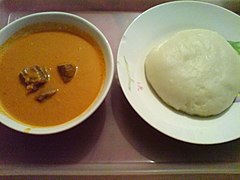| Part of a series on the |
| Culture of the Central African Republic |
|---|
 |
| People |
| Languages |
| Cuisine |
| Religion |
| Music |
| Sport |


Central African cuisine includes the cuisines, cooking traditions, practices, ingredients and foods of the Central African Republic (CAR). Indigenous agriculture in the country includes millet, sorghum, banana, yam,[1] okra, yellow onion, garlic, spinach, rice and palm oil. Imported crops of American origin include maize, manioc (cassava), peanuts, chili peppers,[1] sweet potato and tomato.[2] Additional foods include onions, garlic, chiles and peanuts.[3]
Meat can be scarce in the Central African Republic, although fish is used in a variety of dishes, and other sources of protein include peanuts and insects such as cicadas, grasshoppers, crickets and termites.[3] Common meats in Central African cuisine include chicken and goat.[2] Wild game is also hunted, especially in rural areas and during the grass-burning dry season.[4] Staple foods include starches, such as millet, rice, sesame and sorghum. A variety of vegetables and sauces are also consumed.[1][3]
Roadside stalls sell foods such as baked goods and makara (a type of fried bread), sandwiches, barbecued meat and snacks.[4] In the forests and in markets of Bangui where forest items are sold, caterpillars and the koko leaf are eaten.[4] Restaurants are mostly for expatriates.[4] Wild tubers, leaves, and mushrooms are used.[4] Palm oil is widely used in various dishes.[4]
The capital city of Bangui has western foods and hotel restaurants.[5] The legal drinking age is 18. Muslims are prohibited from drinking alcohol.[5] The PK5 area is known for its smaller restaurants serving reasonably priced traditional dishes.[5]
- ^ a b c Cite error: The named reference
Woodforkwas invoked but never defined (see the help page). - ^ a b Cite error: The named reference
ourwas invoked but never defined (see the help page). - ^ a b c "Central African Republic." Foodspring.com. Accessed June 2011.
- ^ a b c d e f Cite error: The named reference
sorwas invoked but never defined (see the help page). - ^ a b c Central African Republic — Food and Restaurants | iExplore